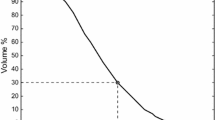Abstract
This study describes a method that uses a genetic algorithm to select optimal beam angles in proton therapy and evaluates the effectiveness of the proposed algorithm in actual patients. In the use of the genetic algorithm to select the optimal angle, a gene represents the angle of each field and a chromosome represents the combination of beam angles. The fitness of the genetic algorithm, which represents the suitability of the chromosome to the solution, was quantified by using the dose distribution. The weighting factors of the organs used for fitness were obtained from clinical data through logistic regression, reflecting the dose characteristics of actual patients. Genetic operations, such as selection, crossover, mutation, and replacement, were used to modify the population and were repeated until an evaluation based on fitness reached the termination criterion. The proposed genetic algorithm was tested by assessing its ability to select optimal beam angles in three patients with liver cancer. The optimal results for fitness, planning target volume (PTV), normal liver, and skin in the population were compared with the clinical treatment plans, a process that took an average of 36.8 minutes. The dose-volume histograms (DVHs) and the fitness of the genetic algorithm plans did not differ significantly from the actual treatment plans. These findings indicate that the proposed genetic algorithm can automatically generate proton treatment plans with the same quality as actual clinical treatment plans.
Similar content being viewed by others
References
X. Zhang et al., Int. J. Radiat. Oncol. Biol. Phys. 67, 620 (2007).
D. C. Weber et al., Int. J. Radiat. Oncol. Biol. Phys. 63, 401 (2005).
G. Noel et al., Strahlenther. Onkol. 178, 480 (2002).
K. Nihei, T. Ogino, S. Ishikura and H. Nishimura, Int. J. Radiat. Oncol. Biol. Phys. 65, 107 (2006).
X. Wang et al., Med. Dosim. 33, 259 (2008).
T. Chiba et al., Clin. Cancer Res. 11, 3799 (2005).
M. Mizumoto et al., Int. J. Radiat. Oncol. Biol. Phys. 82, e529 (2012).
S. J. Gandhi et al., Pract. Radiat. Oncol. 5, 209 (2015).
V. Grégoire et al., ICRU report no. 83, J ICRU 10, NP (2010).
S. L. Berry et al., Pract. Radiat. Oncol. 6, 442 (2016).
K. L. Moore et al., Int. J. Radiat. Oncol. Biol. Phys. 92, 228 (2015).
X. Wang et al., Int. J. Radiat. Oncol. Biol. Phys. 60, 1325 (2004).
D. Djajaputra, Q. Wu, Y. Wu and R. Mohan, Phys. Med. Biol. 48, 3191 (2003).
Y. Li, J. Yao and D. Yao, Phys. Med. Biol. 49, 1915 (2004).
M. Lahanas, D. Baltas and N. Zamboglou, Phys. Med. Biol. 48, 399 (2003).
A. Nicolae et al., Int. J. Radiat. Oncol. Biol. Phys. 97, 822 (2017).
P. Zhang, D. Dean, A. Metzger and C. Sibata, Med. Phys. 28, 1746 (2001).
J. Alfonso, M. Herrero and L. Nunez, Radiat. Oncol. 10, 263 (2015).
S. Söderström and A. Brahme, Int. J. Radiat. Oncol. Biol. Phys. 33, 151 (1995).
J. Stein et al., Med.Phys. 24, 149 (1997).
Acknowledgments
This research was supported by the Basic Science Research Program through the National Research Foundation of Korea (NRF) funded by the Ministry of Education (NRF-2018R1D1A1B07047770), and by a National Research Foundation of Korea (NRF) grant funded by Ministry of Science and ICT (MSIT) of the Korea government (NRF-2019R1F1A1063910).
Author information
Authors and Affiliations
Corresponding authors
Rights and permissions
About this article
Cite this article
Seo, J., Jo, Y., Moon, S. et al. Feasibility Study of Beam Angle Optimization for Proton Treatment Planning Using a Genetic Algorithm. J. Korean Phys. Soc. 77, 312–316 (2020). https://doi.org/10.3938/jkps.77.312
Received:
Revised:
Accepted:
Published:
Issue Date:
DOI: https://doi.org/10.3938/jkps.77.312




